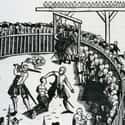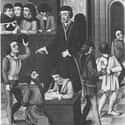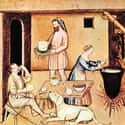-
(#2) Executioners Often Inherited Their Job
You recently arrived in Nuremberg from Bamberg, your birthplace. This will be your first execution in your new home. Vogel’s crime was burning an enemy to death in a stable, and for this you must do your job. You think back to how you came to your profession: “Like father like son,” they say. But your father’s profession was more by default than by design.
The vicious Bavarian magistrate Albrecht II wanted three men hanged. Without an executioner at hand, he picked your father Heinrich out from the crowd and forced him to perform the execution or face a hanging himself. What's a father to do?
Once your father did it, however, nobody wanted to have anything to do with him. As was the tradition for the son of an executioner, you took up the same occupation. You were 18 when you became executioner under your father’s supervision in 1573, and since then, you have performed 361 executions and 345 minor punishments - floggings, as well as ear or finger amputations.
You've executed criminals by rope, sword, the breaking wheel, burning, and drowning. And yet, despite the dishonorable nature of his profession - according to others, anyway - your endearing name: Meister Franz. You're a respected member of the community for your piety. But let us return to Vogel and August 1577.
-
(#1) Some Days There Might Be Multiple Executions, But Today There Is Just One
The stereotypical image of a 16th-century executioner is of a burly, bare-chested fellow in a black hood, wielding a massive axe. This mask may send shivers down the spines of kids today, but the town executioner was likely proud of his well-paying job.
For other executioners across Europe, sometimes they had several victims to deal with in the same day. If you lived in the time of Henry VIII, you hardly had time for a break - there are estimates of as many as 72,000 executions during Henry’s reign.
You would have had your day cut out for you, so to speak. But this time, your task is different. Today, on August 13, 1577, you have but one execution before you. You will not behead bands of pirates or break the bones of your victims on the wheel. Your charge is a man named Hans Vogel, and your duty: Send this repentant sinner off to the promise of salvation.
-
(#4) The Clergy Would Comfort The Condemned
Most who visited condemned prisoners were the clergy. The chaplains who visited Vogel and other prisoners would most likely attempt to soften their hearts and convince them to beg for God’s forgiveness. They would read from the Bible, pray, and preach while appealing to such diverse emotions as fear, sorrow, and hope.
The prisoner was unlikely to see much art in his life. Smaller towns might have had a small church with only the most rudimentary paintings on its walls - if any. The prisoner could have possibly known about heaven and hell from prints. But they were too expensive for the lower classes to own, even with the advent of the printing press. Peasants relied on the clergy to show them their illustrated prayer books.
Undoubtedly, the chaplains who visited Vogel would have brought their prized Bibles or their woodcuts, as well as etchings of saints, sinners, and death. The clerics used these pictures to illustrate their sermons.
You watched as the chaplains led prisoners to recite the Lord’s Prayer. They read from the Lutheran catechism and offered reassuring words. Sometimes they joined along with the jailer or members of their family to sing hymns of consolation. Everyone wanted to believe Vogel would be ready for a penitent and open-hearted death.
-
(#7) The Show Must Go On
Though he had already confessed to his crime, you present Vogel to the “blood court,” where his sentence will become known. You watch the red and black-robed judges in the ornately decorated room.
You listen as the scribe reads the final confession and its tally of offenses, concluding with the formulaic condemnation: “Which being against the laws of the Holy Roman Empire, my Lords have decreed and given sentence that he shall be condemned from life to death by...” The jurors pause to vote on the manner of execution: by rope, sword, fire, water, or the wheel. They choose the sword.
To present this living morality play to as many people as possible, broadsheets circulated weeks in advance. This assured hundreds - and maybe thousands - of onlookers. Vogel must walk a mile to reach his place of execution. His journey is without incident.
This is not always the case, though. You lament when a prisoner behaves wildly or gives trouble. You sharply recall one unruly drunkard who urinated in the open at the gallows. When he learned his sentence, he said he was willing to die, but asked as a favor to fence and fight four of the guards. As you wrote in your journal, “His request was refused.”
-
(#3) Executioners And Prisoners Often Became Acquainted
As is customary with prisoners, you've gotten to know Vogel - after all, you are personally sending him off to eternity. If he had serious wounds or were otherwise ill, you would have nursed him back to health, fulfilling the duties of your secondary profession as a medical consultant.
You might have also requested the execution's delay so he could face a proper death with his health intact. You must have thought it fitting “vogel” meant bird, and if he were truly repentant, he would have assuredly ascended to heaven.
It was not uncommon for prisoners like Vogel to receive visitors, such as family members or the relatives of the victim seeking reconciliation. You knew deep down: Forgiveness is divine, and you must've felt joyful when one condemned killer accepted some oranges and gingerbread from his victim’s widow. You saw it as a sign that she had wholeheartedly forgiven him.
You also might contemplate your role as someone who metes out justice in the name of society and - above all - God. It is your professional and sacred duty to serve as an agent who balances divine and earthly authority.
-
(#6) The Last Meal Could Be A Feast Or Famine
It’s common knowledge the condemned man can request whatever he wants for his last meal. The condemned could order whatever he or she wanted, and in copious amounts - wine and beer included. Of course, imbibing large quantities of spirits at the “hangman’s meal” were often to the advantage of the executioner.
The prisoner was occasionally dead-drunk and nonresistant before actually dying. In one instance, a rogue consumed so much food and drink his stomach had burst as he swung from the gallows. No doubt you also witnessed those prisoners who would not touch a bite.
Once Vogel finishes his meal, your assistants clothe him in a white linen execution gown. Attired in his earthly shroud, he awaits you to preside over the public spectacle to come. The warden announces you with the customary words: “The executioner is at hand.” Dressed in your ceremonial best, you enter and ask Vogel for forgiveness. You then share the traditional drink of peace with him. After a few words, you move on to the waiting judge and jury.
New Random Displays Display All By Ranking
About This Tool
Many people think that the executioners in the Middle Ages in Europe were ruthless people wearing masks and carrying an ax, killing people without blinking, but in fact, this is an illusion of the image of the executioner. In the 16th century, top executioners were also excellent doctors, and they probably saved more people than they killed. The real medieval executioner is a profession that was misunderstood and discriminated against but plays a key role.
In the 16th century, Europe was turbulent and the public security situation was poor. All countries were working hard to improve the criminal law enforcement situation. The executioner was particularly important. The random tool introduced 8 details about what it was like to be a medieval executioner.
Our data comes from Ranker, If you want to participate in the ranking of items displayed on this page, please click here.
















